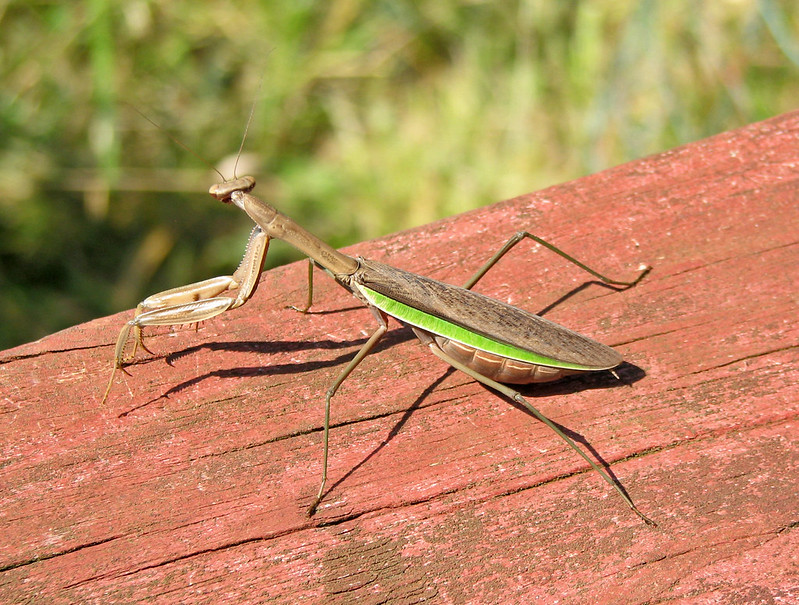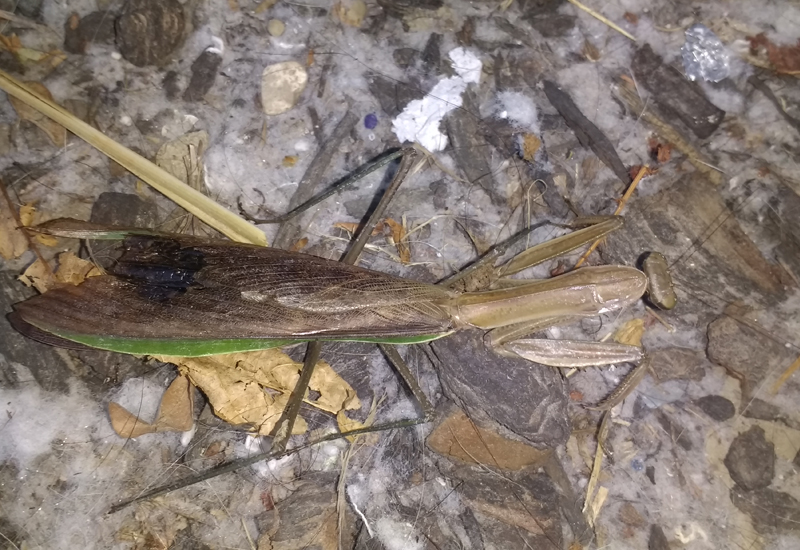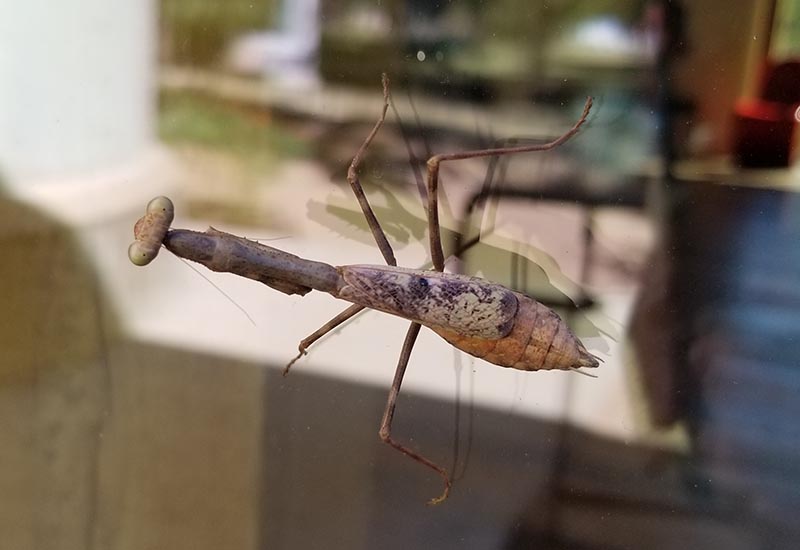The Asian mantis and the Carolina mantis are two fascinating species of praying mantises that intrigue insect enthusiasts and gardeners alike.
While they share some similar traits, the differences between the two species make them distinct predators in their respective environments.
The Asian mantis, or Chinese mantis, is a non-native species in the United States, often considered an invasive species.
In contrast, the Carolina mantis is native to North America and is a significant predator of insects in various landscapes.


Asina Mantis source: I, Luc Viatour, CC BY-SA 3.0, via Wikimedia Commons
Both species are generally mottled gray, brown, or green, which provides camouflage, enabling them to blend in with their surroundings while hunting for prey.
A few key differences between these two mantis species include their size, origin, and the appearance of their ootheca, or egg case.
The Asian mantis is larger than the Carolina mantis, with a length of 2 to 5 inches, while the Carolina mantis typically reaches around 2.5 inches in length.
The Carolina mantis has a narrower and longer ootheca compared to the Chinese mantis.
Furthermore, the wings of adult Carolina mantis cover only about two-thirds of their abdomen, unlike those of the Chinese mantis, which cover the entire abdomen.
Asian Mantis vs Carolina Mantis
General Differences
Asian mantises consist of two commonly found species: the Chinese mantis (Tenodera sinensis) and the Mantis religiosa. In contrast, the native species found in the US is the Carolina mantis (Stagmomantis carolina).
- Chinese mantis: grows up to 5 inches, usually tan to pale brown with green/yellow striping1.
- Mantis religiosa: often referred to as the European mantis, smaller in size.
- Carolina mantis: grows up to 2.5 inches, comes in green, gray, and brown varieties2.

Identification
Chinese Mantid vs Carolina Mantid
Key differences can help identify the Chinese mantid (Tenodera sinensis) from the Carolina mantid (Stagmomantis carolina):
- Face plate: Carolina mantids have a more rectangular face plate, while Chinese mantids have a square one3.
- Wings: In Carolina mantids, adult wings cover about two-thirds of their abdomen, while in Chinese mantids, they cover the whole abdomen3.
- Spot on the front legs: Chinese mantids possess a large spot on the inside of their front legs near the body, while Carolina mantids do not3.
Comparison table:
| Feature | Chinese Mantid | Carolina Mantid |
|---|---|---|
| Size | Up to 5 inches | Up to 2.5 inches |
| Color | Tan, pale brown, with green/yellow striping | Green, gray, brown |
| Face plate shape | Square | Rectangular |
| Wings coverage | Covers whole abdomen | Covers two-thirds of abdomen |
| Spot on front legs | Present | Absent |
Habitat and Distribution
Native Regions
- The Asian mantis (aka Chinese mantis), Tenodera sinensis, is native to eastern Asia, including China, Japan, and Korea.
- In contrast, the Carolina mantis, Stagmomantis carolina, is a native species of North America, predominantly found in the southeastern United States.
Introduced Areas
- The Asian mantis has been introduced to North America and other regions, primarily for pest management purposes, but its effectiveness is debatable.
- The Carolina mantis typically remains within its native range.
Distribution in gardens is common for both mantids as they actively search for prey, making them natural pest control agents.
However, the Asian mantis is considered invasive in some areas.
Table: Comparison of Asian Mantis and Carolina Mantis
| Asian Mantis (Chinese Mantis) | Carolina Mantis | |
|---|---|---|
| Native to | Eastern Asia | North America |
| Size | Larger (up to 5 inches) | Smaller (up to 2.5 inches) |
| Introduced | North America and other regions | No substantial introduced range |
| In Gardens | Common | Common |
| Invasive | In some areas | No |
In summary:
- Both mantids are native to different regions: Asia for the Asian mantis, and North America for the Carolina mantis.
- Both species are commonly found in gardens, but the Asian mantis is considered invasive in some places.
- The Asian mantis is generally larger than the Carolina mantis.

Physical Features and Coloration
Size and Shape
- Carolina mantis: Native to the US, they are smaller in size, reaching about 2 inches in length when full grown with wings.
- Asian mantis: Non-native species like the Chinese mantis are larger, with a size of 3 to 5 inches in length.
Their body shapes are also different, but both types have large, widely spaced eyes, and the ability to pivot their heads, helping them locate and capture prey.
Color Patterns
Carolina mantids usually display a dusty-brown color, which aids in their camouflage.
On the other hand, Asian mantids like the Chinese mantis have a color range of green to light-brown.
| Feature | Carolina Mantis | Asian Mantis |
|---|---|---|
| Size | 2 inches | 3 to 5 inches |
| Color | Dusty-brown | Green, light-brown |
The colors mentioned are not exclusive; variations can occur within each species.
Reproduction and Life Cycle
Mating
Both Asian and Carolina mantises engage in a mating process where the male approaches the female.
In general, the male praying mantis is more cautious, as the larger female mantis sometimes consumes the male during mating.
Egg Laying
- Asian mantis: The female Chinese mantis lays a larger egg case called an ootheca on various surfaces such as twigs, stems, rocks, or buildings.
- Carolina mantis: The female Carolina mantis also lays an ootheca but it’s generally smaller in size.

Hatching
Asian mantis:
- Produces a larger number of eggs in each ootheca
- Nymphs emerge after incubation
Carolina mantis:
- Produces fewer eggs in each ootheca
- Nymphs hatch and resemble small, wingless adults
| Feature | Asian Mantis | Carolina Mantis |
|---|---|---|
| Egg case size | Larger (called “ootheca”) | Smaller ootheca |
| Egg-laying | On various surfaces | On twigs, stems, rocks |
| Number of eggs | Generally higher | Lower |
| Nymph appearance | Wingless, resembling adults | Wingless, resembling adults |
Feeding Habits and Prey
Diet
Asian mantids, specifically the Chinese mantid, and Carolina mantids, both belong to the Mantodea order and share similar diets. These insects typically feed on:
- Bees
- Butterflies
- Grasshoppers
- Small reptiles
- Amphibians
Their specialized front legs help them catch prey, which might also include beneficial pollinators and caterpillars.
Predators and Threats
Mantids face various predators and threats in their natural habitats. Some common predators include:
- Birds
- Hummingbirds
- Spiders
- Lizards
- Frogs
- Snakes
Here’s a comparison table highlighting some differences between Asian and Carolina mantids.
| Feature | Asian mantids | Carolina mantids |
|---|---|---|
| Size | 3 to 5 inches long | About 2 inches long |
| Color | Green and light brown | Dusty brown |
| Origin | Non-native (invasive) | Native |
Carolina mantids, being a native species, have developed camouflage coloration that helps them blend in with their surroundings, making them less visible to predators and more effective in pest control.
On the other hand, Asian mantids, especially Chinese mantids, are considered invasive and have been sold commercially for pest management but seem to have little value in this regard.
The difference in size and coloration might play a role in their effectiveness, as well as their adaptation to local environments.

Role in Ecosystem and Human Interaction
Pollination and Pest Control
The Carolina mantis and Asian mantis play essential roles in our ecosystems, particularly in pollination and pest control.
Although mantids, in general, are not primary pollinators, their presence indirectly promotes pollination by regulating arthropod populations.
- Carolina mantis: A native species that aids in controlling harmful insect populations in their environment. More information on Carolina mantis
- Asian mantis: A non-native species that also helps in managing pests, but can have negative impacts on native ecosystems. More information on Chinese mantis
Comparison Table
| Feature | Carolina Mantis | Asian Mantis |
|---|---|---|
| Pollination Role | Indirect | Indirect |
| Pest Control | Yes | Yes |
| Native Status | Native to North America | Non-native (invasive) |
As Pets
Mantises are fascinating insects and have gained popularity as pets. Their unique appearance and interesting behavior make them desirable for enthusiasts.
- Larvae growth: Both Carolina and Asian mantis species grow throughout the summer, usually molting five to ten times in captivity before reaching adulthood.
- Captivity environments: Both mantis species require a temperature-controlled environment with proper humidity and access to food sources such as flies and crickets.
Pros and Cons of Keeping Mantises as Pets
Pros:
- Easy to care for: Mantises are low-maintenance pets requiring simple habitats and feeding routines.
- Educational: Observing mantises up close provides an opportunity to learn about insect behavior and growth.
Cons:
- Short lifespan: Mantises typically live for only one season, making it necessary to obtain a new pet each year.
- Ethical concerns: Non-native mantis species like the Asian giant hornet can disrupt local ecosystems, especially when released into the wild (e.g., around Philadelphia). It is important to consider the potential impact on native species when keeping non-native insects as pets.
Overall, mantises play vital roles in ecosystems as pest controllers and have become fascinating pets for those interested in observing insect behavior.
However, always consider the potential impact on native ecosystems and follow responsible pet-keeping practices.

Myths and Misconceptions
The Asian Mantis and the Carolina Mantis are often subjects of misconceptions. Many people believe these mantises to be indistinguishable from each other. However, there are some key differences between them.
- Both the Carolina Mantid and the Asian Mantis can be beneficial predators. The latter, though, is considered invasive.
- The internet can sometimes perpetuate these misconceptions. Fact-checking through credible sources is essential.
- The native Carolina Mantid’s abdomen is generally slimmer than the Asian Mantis’.
- People might incorrectly assume that all mantises found in the wild are of the native species.
- Both mantids can be spotted during spring. Not all springtime observations can be classified as a particular species.
A comparative table of Asian Mantis and Carolina Mantis helps clarify their differences:
| Asian Mantis | Carolina Mantis | |
|---|---|---|
| Origin | Asia | North America |
| Size | Large, up to 5″ | Smaller, around 2.5″ |
| Color | Green or brown | Gray, green, or brown |
| Abdomen | Wider and rounder | Slimmer and narrower |
| Presence in the wild | Widespread | Native to North America |
Some misconceptions may arise from the presence of other species, such as the narrow-winged mantis.
It is another non-native species that coexists with the Carolina and Asian mantises.
It is crucial to base our understanding of these fascinating insects on accurate information.
So, let’s appreciate these creatures for their unique characteristics and roles in their respective ecosystems.

Conclusion
In conclusion, Asian mantises (Tenodera sinensis) and Carolina mantises (Stagmomantis carolina) differ in several ways.
Asian mantises are larger, measuring up to 4.3 inches, while Carolina mantises are smaller, around 2.5 inches.
Asian mantises have a distinct color range from green to brown, blending with their surroundings, while Carolina mantises are typically light brown with a narrow, green line along the edge of their wings.
Asian mantises exhibit a more aggressive behavior, preying on larger insects, while Carolina mantises are calmer and feed on smaller prey.
These variations highlight their diverse characteristics and ecological roles.
Footnotes
Reader Emails
Over the years, our website, whatsthatbug.com has received hundreds of letters and some interesting images asking us about these insects. Scroll down to have a look at some of them.
Letter 1 – Carolina Mantis

Location: 78634, Texas
April 6, 2016
The next cool thing I found was a praying mantis on the GH door (see attached)!
With an utter invasion of lady beetles and other critters we went from aphids everywhere to ZILCH! wuhu! Even the milkweeds are almost free!
So cool to live here :)))))
You guys rock!!!!
Sandy

Hi Again Sandy,
We are thrilled to post your image of a female Carolina Mantis, a native species. We identified it thanks to this BugGuide image that depicts the black spot in the middle of the wing.
We just finished a posting regarding native versus non-native Mantids in the garden, so the sending of your newest image was perfectly timed.
We are also pleased to hear that predators are controlling the aphids in your garden and greenhouse.
Letter 2 – Carolina Mantis and European Mantis

Geographic location of the bug: Johnson city, tx
Date: 09/26/2019
Time: 12:23 PM EDT
Your letter to the bugman: Hey! I found what I believe to be two green European Mantids at my place of work a couple weeks ago but this morning I found this dark colored mantis hunting a fly.
I’m not sure if it’s just a color variant of the same species or something different? I also will attach pics of my self identified Eurpean Mantids because I’m not 100% on my ID. Thanks!
How you want your letter signed: Lisa Keys

Dear Lisa,
We agree with your identification of the European Mantid which can be distinguished from Chinese Mantids which have striped faces as indicated in this BugGuide image.
Your image of a female European Mantis does not show the distinguishing black spot or black spot with a white bull’s eye where the foreleg meets the body on the ventral surface as indicated on BugGuide.
The darker Mantid in question is a female Carolina Mantis, a smaller native species. Both European Mantids and Chinese Mantids can be purchased as ootheca or egg cases for gardeners who want to control insects without spraying, which is a noble idea, however, both species are much larger than native Mantids that they will prey upon.
We do not endorse introducing non-native Mantids to the garden as we promote the preservation of native species. Here is a BugGuide image of a Carolina Mantid.

Interesting! I thought it might be a Carolina mantis but she was so big, around 3-3.5 inches, that it threw me off a bit. I currently keep these guys as work pets since I knew the first was a non native species at least.
I’m sure keeping one or two doesnt have much effect on their population if they are already in the area but I have always enjoyed keeping and caring for mantids even when I was younger. Thanks for your help!
Letter 3 – Carolina Mantis in Captivity
Praying Mantis question
Location: Savannah, GA
December 8, 2010 9:17 pm
Hi there,
We found a praying mantis on our front door about 2 months ago and we’ve set up a terrarium for him. We feed him live crickets and have lots of fun watching him mosey around the cage.
He mostly likes to hang from the top of the cage and keeps his front legs in the ”praying” position. Recently, he has not been able to support the back half of his body and has resorted to hanging by his front legs. It appears that he cannot lift his back end up at all.
Every time I’ve seen him go to catch a cricket, he misses it, so I’m not sure when he ate his last one. It’s so sad to see and we’re not sure what to do! Do you have any ideas as to what’s wrong?
Signature: jjzmgailey

Your mantis appears to be a female Carolina Mantis, but the photo is blurry that we cannot be certain of the species.
Daniel recently kept a female California Mantis in captivity for a few weeks feeding her crickets but she died shortly before a scheduled local television news appearance, and this sad event is documented in our archives.
It is possible that your Mantis is just at the end of her life cycle.
Letter 4 – Carolina Mantis eats Monarch
Mantis vs Monarch
Hey Bugman,
I love this site! You have helped me identify the bagworns and army worms that have invaded my country yard this year, but today we had a nice treat in the garden.
My children spotted this struggling monarch and thought he was just injured. Upon closer inspection we discovered that he was trapped by a well disguised mantis!
While we don’t like to lose a monarch, it was fascinating to see nature in action!
Keeping it Country
Fairview, Texas (north of Dallas)

Dear Keeping,
Thanks so much for sending us your fascinating Food Chain image. Mantids often wait in blossoms for unsuspecting pollinators like wasps, bees and butterlies. Your mantis appears to be immature as the wings don’t look fully developed.
Ed. Note: Thanks to a comment, we now know that this is a Carolina Mantis.
The post Asian Mantis vs Carolina Mantis: Intriguing Battle of the Bugs appeared first on What's That Bug?.

No comments:
Post a Comment